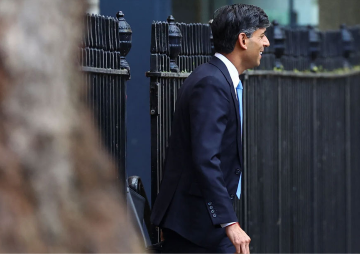Even the last excuse for not declaring Pakistan Army and its intelligence arm, Inter Services Intelligence Directorate, as global terrorist entities, disappeared with the two bullets that killed world's most wanted terrorist, Osama bin Laden, in a house adjacent to Pakistan Military Academy in Abbottabad, just about two hours drive from the ISI headquarters in Aabpara, Islamabad.
As per the guidelines prescribed by the UN Security Council Committee Concerning al Qaeda and the Taliban and Associated Individuals and Entities (Resolution 1267{1999}), five conditions are necessary for any entity to be listed under the Sanctions List of Terrorist Entities - 1) Participating in the financing, planning, facilitating, preparing or perpetrating of acts or activities by, in conjunction with, under the name of, on behalf of, or in support of al Qaeda, Osama bin Laden or the Taliban, or any cell, affiliate, splinter group or derivative thereof; 2) supply, selling or transferring arms and related material AQ, OBL or the Taliban, or any cell, affiliate, splinter group, or derivative thereof; 3) recruiting for AQ, OBL, or the Taliban or any cell, affiliate etc: 4) otherwise supporting acts or activities of AQ, OBL, or the Taliban etc; and 5) Other acts and activity associated with AQ, OBL, or the Taliban, etc.
Participating in the financing, planning: The fact that Osama bin Laden was living in the protective custody of ISI for over five years should fulfil this first condition. There may be doubts about how much did the Army know about the US Special Forces' covert action in Abbottabad in the wee hours of May 2 but there cannot be any doubt that the Army was well aware of Laden's safe house near the military academy. Abbottabad is not only a garrison town but also the headquarters of a Brigade belonging to Army's 2nd Artillery Div. (Gujranwala XXX Corps). Interestingly, it also houses Army's Mountain Warfare School where Special Services Group commandos are trained in HALO (High Altitude Low Opening) courses. Several senior retired Army officers have residences in the district which also has quite a few military establishments and officers' messes.
A mysterious building of the magnitude of the Waziristan Haveli, as the locals called it, could not have come up without alerting the local intelligence, Army and police officials. By all accounts, the Waziristan Manzil was constructed in 2005, a period when Pakistan Army chief General Ashfaq Kayani was the head of ISI and was part of the CIA-ISI operation to hunt down Osama bin Laden. Kayani, who succeeded in getting close to General Pervez Musharraf, and Pentagon after the 9/11 attacks, was largely instrumental in protecting ISI's 'strategic assets' among the terrorist groups. One such asset, as recent events have revealed, was al Qaeda chief Osama bin Laden.
The direct role of ISI and Pakistan in the Mumbai attacks of November 2008 and the July 2008 attack on the Indian Embassy in Kabul should be regarded as 'perpetrating of acts' in conjunction with AQ, Laden and Taliban. The aim of both the attacks was to help AQ and Taliban escape the intense military offensive launched by the western forces in Afghanistan-Pakistan areas by creating a 'hot spot' elsewhere.
Supplying, selling or transferring arms to AQ, Taliban: Besides Osama bin Laden, Pakistan Army and ISI have been hand in glove with the Taliban for over 10 years, helping them with safe houses, recruitment bases, training and weapons. Their alliances have been effectively documented not only by the Indian security agencies but also by different western security and intelligence agencies. Of the several documented nexus between the Taliban-al Qaeda and ISI, a less known instance is worth quoting here. Well known Pakistani author Ahmed Rashid quoted a North Atlantic Treaty Organisation (NATO) report on Operation Medusa (September 4-17, 2006) in Panjwal district, Afghanistan, which accused the ISI of shoring up the Taliban's military capability. So intense was the firefight that the Taliban, according to NATO, used 400,000 rounds of ammunition, 2,000 rocket-propelled grenades and 1,000 mortar shells. The ammunition dumps discovered by the NATO and Afghan forces revealed that the Taliban had over 2 million rounds of ammunition in Panjwal alone. The NATO force captured 160 Taliban, most of them Pakistanis who detailed the ISI's support for the Taliban, including setting up two training camps outside Quetta. It was also revealed that the Taliban recruits were housed and indoctrinated in madrassas run by radical groups supported by ISI.
Recruiting for AQ, Taliban and affiliates: It was during Kayani's tenure as DG ISI that new training camps were set up in Khyber Pakhtunkhwa for terrorists leaving for Kashmir and Afghanistan. In June 2006, reports emerged about the fresh recruitment drive launched by the terrorist groups and the sprouting of training camps. Dozens of aspiring recruits from Khyber Pakhtunwa and FATA towns were sent each month to training camps in Wana in South Waziristan. According to the report, at least three major terrorist groups maintained their liaison and recruitment offices in the Timergara area of Lower Dir District. These included the Hizb-ul Mujahideen (HM), Al Badr Mujahideen, renamed as Al Suffa Foundation, and LeT, renamed as Jamaat-ud-Dawa (JuD). For instance, after the October 2005 earthquake in Pakistan Occupied Kashmir (PoK) when terrorist groups like Lashkar-e-Tayyeba (LeT) lost their training infrastructure and other facilities it was ISI which facilitated the mass transfer of LeT cadre and leadership to safer areas of Dir and Upper Dir in Khyber Pakhtunkhwa. These camps were utilised to recruit cadres for the Taliban and al Qaeda forces fighting the western alliance in Afghanistan.
Supporting AQ, Taliban etc: In fact, Kayani, contrary to the image he has managed to create in the western capitals of a professional soldier, has been assiduously cultivating terrorist groups as 'combat reserves', protecting them from international scrutiny and allowing them to recoup and regroup in different parts of Pakistan. When al Qaeda and Taliban leaders and cadre fled the US bombing of their hideouts in Afghanistan after 9/11, Kayani was the Director General of Military Operations in charge of the US-Pakistan alliance in the Global War on Terror. It is now fairly well documented that al Qaeda and Taliban managed to eke out a sanctuary on both sides of Durand Line between 2002 and 2007, the period when Kayani was DGMO and DG ISI.
As DG ISI, Kayani was also responsible for the release of over 2,000 terrorists arrested from different parts of Pakistan on American insistence. Among them were Harkat-ul Mujahideen chief Fazlur Rehman Kahlil (December 2004) and Harkat-ul Jihad al Islami chief Qari Saifullah Akhtar (May 2007), two of the Afghan jihad veterans who were instrumental in reorganising terrorist strategies and operations on behalf of the Army. Akhtar was an adviser to Taliban chief Mullah Omar till October 2001. No less important is the fact that a close confidante of Akhtar was Illyas Kashmiri, whose role in several recent terrorist incidents is no secret.
In fact, there is no dearth of evidence to prove that Pakistan and ISI could be declared as terrorist entities. The Abbottabad incident has only added weight to an urgent need to impose severe sanctions on these two entities if the world wanted to be rid of the scourge of terrorism.
( Wilson John is Vice-President and Senior Fellow, Observer Research Foundation, New Delhi)
Courtesy: The Pioneer
The views expressed above belong to the author(s). ORF research and analyses now available on Telegram! Click here to access our curated content — blogs, longforms and interviews.




 PREV
PREV

